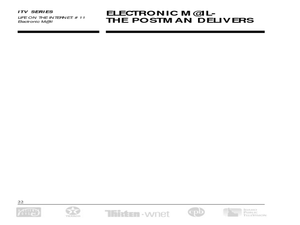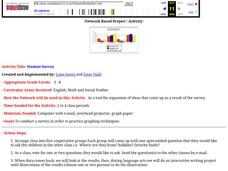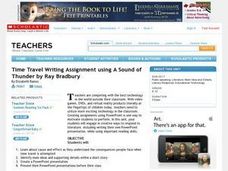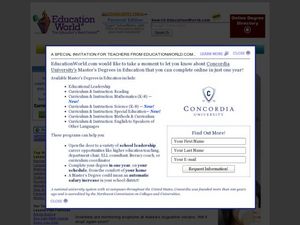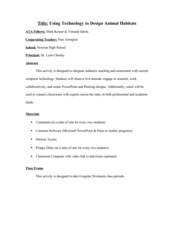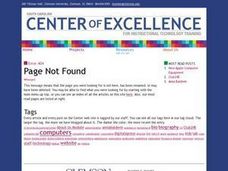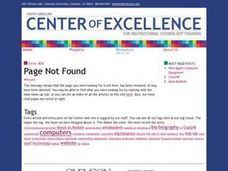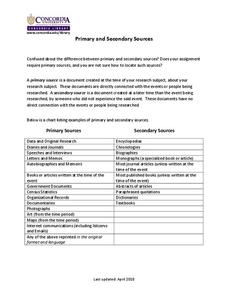Curated OER
Foreshadowing and Prediction: W.W. Jacob's, "The Monkey's Paw"
W.W. Jacobs' story "The Monkey's Paw" provides plenty of foreshadowing which readers use to make predictions in this tightly composed, sound instructional plan. Your class reads the story, recording predictions and checking for veracity...
Curated OER
How to Make a College Plan
Log on and create learner accounts on the Big Future website, then let the lesson begin! Pupils log onto the website to explore college options. They use the tools provided to create a step-by-step college plan. This will help relieve...
College Board
Special Focus: Inference
Statistics is all about making inferences! A lesson guide explains the meaning of inferences and how to use statistics to make them. The resource provides instruction as well as information about the topic on the AP® Statistics exam.
Curated OER
International Email Connections
Students are matched with international students and communicate through email. They concentrate on sentence structure, spelling, details, and composition in their communication.
Curated OER
How to keep a timecard in Excel
Students fill out a timecard of family activities in Microsoft Excel. In this Excel lesson plan, students use the program to fill in times they do various activities with their families.
Curated OER
Key Pals
Second graders analyze the proper form of friendly letters and write emails to a key pal. In this friendly letters and email lesson, 2nd graders discuss sending friendly letters and view examples of the letter format. Students then...
Curated OER
Lesson 4:Writing a Letter
Students write business letters and emails. In this letter activity, students use the seven-day road trip they had planned in a previous activity and contact the Chambers of Commerce for the cities they plan to visit. They write business...
Curated OER
Street Art And Hopscotch
Students use a grid to help them draw outdoor paintings on the street of Keith Haring's work with haring people. In this painting lesson plan, students can also play a hopscotch games on their painting.
Curated OER
Electronic Mail - The Postman Delivers
Students examine the use of electronic mail. In this electronic mail lesson, students determine how to use different e-mail programs and how they access information using this medium. They discuss how e-mail differs from regular mail and...
Curated OER
A Year in Arizona
Fourth graders create a calendar about their state. In this state calendar lesson, 4th graders select a state theme and create a calendar based on that theme. Students write paragraphs for each month related to the theme and design the...
Curated OER
Student Survey
Students create questions they would like to ask another class of Students, send the questions by email, examine results, and create slideshow illustrating results.
Curated OER
Know Your Telephone
Students describe the parts of a cell phone and role-play a phone call to a customer service representative. They compare/contrast the price of owning and using a cell phone in the U.S. and Venezuela.
Curated OER
Using Repeat Photography to Map Environmental Hazards
Learners investigate the changes of their environment by experimenting with photography. In this environmental observation lesson, students compare historic photographs of areas with pictures they have just taken. Learners...
Curated OER
Using Photoshop to Create a Travel Brochure
Students create a travel brochure. In this Social Studies lesson, students observe and discuss different travel brochures. Students look on the Internet and find interesting photos for a particular place. Students then insert their...
Curated OER
Explore Efficient Energy Uses
In this energy learning exercise, students explore different ways to conserve energy. They write a short description for each of the 10 methods presented.
Curated OER
Time Travel Writing Assignment using "A Sound of Thunder" by Ray Bradbury
Students examine the consequences of time travel through the analysis of the short story "A Sound of Thunder" by Ray Bradbury. They watch a PowerPoint presentation, conduct Internet research on endangered ecosystems, and create a...
Curated OER
Scientists Use Web Site to Report Volcano Activity
Students react to statements about volcanoes, then read a news article about scientists monitoring eruptions at Augustine volcano in Alaska. For this earth science and current events lesson, the teacher introduces the lesson with a...
Curated OER
Using Technology to Design Animal Habitats
Young scholars study the relationship between an animal and where it lives. In this habitats lesson students research to obtain data and create a professional report.
Curated OER
Historical Travel Brochure
Fourth graders answer the question, Where in America did history take place? Through investigation as a travel agent, they discover that history is not an isolated event. They use a wide variety of technological resources to create their...
Curated OER
The Unofficial Guide to Middle School
Sixth graders use Inspiration, Microsoft Word, Microsoft Publisher, digital camera, scanners, and video camera
Concordia University
Primary and Secondary Sources
Show your class the difference between primary sources and secondary sources. The first page provides a list of examples of each type of source. While they research, pupils can refer back to the list quickly to make sure they are reading...
Curated OER
Internet: Introducing Email
Students discuss the use and misuse of email and identify six new technology terms. After opening a word document, they experiment with fonts and sentence writing before pasting it into their email. The lesson concludes with students...
Curated OER
Westward Movement/the Oregon Trail Using Power Point
Fifth graders research and examine the Westward Movement using a computer. they create their own word search from facts they discover in their research or while interacting with the Oregon Trail software. They create PowerPoint...
Curated OER
Objects Used at School
For this school supplies word and picture matching worksheet, students examine 3 pictures of objects commonly used at school. Students match these to the words that name each object.








